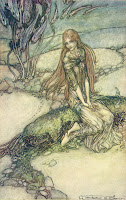 |
| Handmade Celtic mermaid and seal ceramic tile available on Etsy |
by Eleina Fae
Contributing urban fairy
(Note: Neither la Vie Sirene nor Siren School are responsible for the personal opinions of Miss Fae)
We all know how it feels to be lumped into a general category, worse yet, one to which we don't belong. If I had a shekel for every time I've been called a pixie, I'd be a gazillionaire!
- "You're from Germany. I can tell." "Actually, I'm Dutch. I'm from the Netherlands.. you know, Holland?" "Same thing."
- "You'll have to speak English. I don't speak Mexican." "Neither do I, because there is no such language! It's Spanish! Besides, I'm from Portugal." "Same thing."
- "I can't tell you Chinese apart." "But I'm Korean. And he's Vietnamese. And she's from Japan!" "Same thing."
Not the same thing!
Perhaps no fae race has been subject to more confusion and stereotyping than that of the mers. Well, I am here today to set the record straight!
 |
| Syrian Atargatis Mermaid Goddess Ruler of the Seven Seas |
To start, let's consider the consensus definition of mermaids: 'legendary aquatic creatures with the upper body of female humans and the tail of a fish.' This is quite correct. But what many fail to realize is that the term legendary does not mean mythical; it means famous, celebrated, noteworthy, that sort of thing.
Like most life forms, they are ever evolving, with body attributes varying depending on their region. Whereas the tail to leg transformation used to be a painful and costly process, most modern mermaids in North America are able to make the transition to duobus cruribus (two legs), simply by exiting the water. In certain cases, most notably in the Sahara desert, mers who are kept from the water for an extended period of time may lose their ability to return to tail form. Some of these opt to transition into genies.
 |
| Illustration by Arthur Rackham, 1909 from the 1811 book Undine by Baron Friedrich de la Motte Fouque |
These elementals are described in European folk tales as fairy-like creatures, but of course, this is not exactly accurate.
Generations ago, tabloid journalism over a German water nymph who cursed her unfaithful husband led to the race being saddled with responsibility for what is unfairly known as the Ondine Curse, i.e. sleep apnea.
As water spirits, undine tend to stay close to home in forest pools and waterfalls. Their soothing voices are sometimes mistaken for trickling or running water. Prior to the faemenist movement, undine were deprived of souls, unless they became a wife and mother. Those who stood up for their independence as single females were labeled wraiths —hard to believe in this day and age.
 |
| Warwick Hutton (presumed attribution) |
These lovelies hail from the Orkney and Shetland Islands and are similar to swan maidens, as far as their type of legend goes. While living as seals in the ocean, they shed their skin on land to become human. In the 20th Century, the discovery of seal skins has caused outrage and confusion among unwitting Greenpeace activists who, being unfamiliar with Selkies, assumed the worst.
SIRENIA
 |
| by Casey Virata |
and finally... the primary racist bungle
 |
| Odysseus and the Sirens, eponymous vase of the Siren Painter ca. 480-470 BC |
This is an issue I am not going to pussyfoot around. For too long those who have striven for political correctness have muddied the siren waters, confounding moderns and slandering decent siren folk. In short, sirens do not have mertails. These sweet songbirds of the seashore have wings. They also have arms. How else would they be able to play their harps?
Aside from their depiction in current cosplay and fantasy stories, sirens have long been identifiable as the beautiful bird woman whose song was so exquisite that mariners shipwrecked themselves in their attempt to draw close to the crags on which the sirens perched and sang. More often than not, when a cluster of sirens witnessed a ship getting too close to shore they tried to warn them off for safety. But the sirens' beguiling voices had the opposite effect and lured them in even closer, often to the sailor's doom.
And so the term femmes fatales became a tragic truism, though having nothing to do with malicious or homicidal intent on the part of the siren singers. In fact, the mortality rate among mariners so distressed the siren community that they went silent, sacrificing their melodious music for the lives of the seamen who pass nearby.
In 1917, Franz Kafka noted the dearth of siren songs, and in consequence, wrote The Silence of the Sirens
"Now the Sirens have a still more fatal weapon than their song, namely their silence. And though admittedly such a thing never happened, it is still conceivable that someone might possibly have escaped from their singing; but from their silence certainly never."In recent years, the sirens have begun to slowly re-emerge from the depths of the windswept crags. Their song is now more felt than heard. You must tune in very intently when listening for them, because now their song may only be heard within the hearer's soul. Think back. I've bet you've heard it once or twice yourself.
